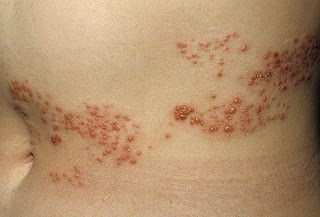Got Skin Problems?
Is your skin itching, breaking out, covered in a rash, or playing host to strange spots? Skin inflammation, changes in texture or color, and spots may be the result of infection, a chronic skin condition, or contact with an allergen or irritant. You can learn to recognize common adult skin problems. Yet, while many are minor, they may signal something more serious, so always consult a doctor for proper diagnosis.
Shingles (Herpes Zoster)
Shingles starts with burning, tingling, or very sensitive skin. A rash of raised dots develops into painful blisters that last about two weeks. Shingles often occurs on the trunk and buttocks, but can appear anywhere. Most people recover, but pain, numbness, and itching linger for many -- and may last for months, years, or the rest of their lives. Treatment with antiviral drugs, steroids, antidepressants, and topical agents can help.
Hives (Urticaria)
A common allergic reaction that looks like welts, hives are often itchy, and sometimes stinging or burning. Hives vary in size and may join together to form larger areas. They may appear anywhere and last minutes or days. Medications, foods, food additives, temperature extremes, and infections like strep throat are some causes of hives. Antihistamines can provide relief.
Psoriasis
A non-contagious rash of thick red plaques covered with white or silvery scales, psoriasis usually affects the scalp, elbows, knees, and lower back. The rash can heal and recur throughout life. The cause of psoriasis is unknown, but the immune system triggers new skin cells to develop too quickly. Treatments include medications applied to the skin, light therapy, and medications taken by mouth, injection or infusion.
Eczema
Eczema describes several non-contagious conditions where skin is inflamed, red, dry, and itchy. Stress, irritants (like soaps), allergens, and climate can trigger flare-ups though they're not eczema's exact cause, which is unknown. In adults, eczema often occurs on the elbows and hands, and in "bending" areas, such as inside the elbows. Treatments include topical or oral medications and shots.
Rosacea
Often beginning as a tendency to flush easily, rosacea causes redness on the nose, chin, cheeks, forehead, even the eyes. The redness may intensify over time, taking on a ruddy appearance with visible blood vessels. In some cases, thickened skin, bumps and pus-filled pimples can develop. Rosacea treatment includes medications as well as surgical procedures such as laser therapy, dermabrasion, and electrocautery to reshape affected areas.
Cold Sores (Fever Blisters)
Small, painful, fluid-filled blisters on the mouth or nose, cold sores are caused by the herpes simplex virus. Lasting about 10 days, cold sores are very contagious. Triggers can include fever, too much sun, stress, or hormonal changes such as menstruation. Antiviral pills or creams can be used as treatment, but call your doctor if sores contain pus, there is spreading redness, you have a fever, or if your eyes become irritated.









